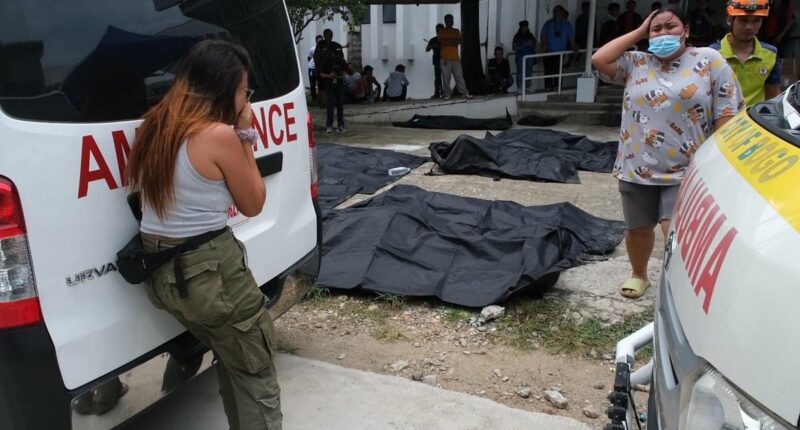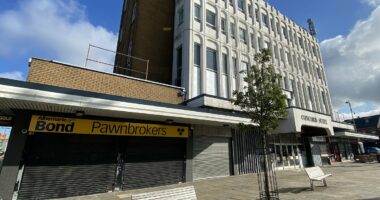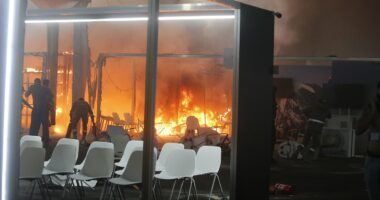Share this @internewscast.com
More than 60 people have been killed in the Philippines after a 6.9-magnitude earthquake collapsed houses and nightclubs.
A powerful earthquake measuring 6.9 on the Richter scale struck around 10pm local time on Tuesday (3pm BST), causing numerous residents to become trapped in the ruins of their homes, clubs, and other enterprises in the city of Bogo and neighboring rural areas of Cebu province, authorities reported.
On Wednesday, rescuers were rushing to locate survivors. The efforts included army units, police, and civilian volunteers, who were assisted by digging machinery and sniffer dogs, conducting door-to-door searches for those in need of rescue.
The earthquake originated from movement along an undersea fault at a perilously shallow depth of three miles and was located approximately 12 miles northeast of Bogo. This coastal city, home to around 90,000 residents in Cebu province, accounted for about half of the reported fatalities, officials stated.
Officials indicated that the casualty numbers were anticipated to climb in Bogo. They also noted that ongoing rain, along with damaged infrastructure such as bridges and roads, was hindering rescue operations.
The Philippine government is considering whether to seek help from foreign governments based on an ongoing rapid damage assessment, officials said.
Efforts to expedite search and rescue operations in a mountain village affected by a landslide and fallen rocks were in progress, involving the transport of a backhoe, as noted by Rex Ygot, a disaster-mitigation officer in Bogo city.
‘There are multiple hazards making movement difficult in the vicinity,’ stated Glenn Ursal, another disaster-mitigation officer, who also reported that some survivors had been transported to a hospital from the mountain village.

Villages mourn the death of their relatives after the earthquake. It has been reported that more than 70 people died after the 6.9 magnitude tremor struck

Rescuers search for three residents who were trapped in the rubble in the early hours of Wednesday

Several people across the area were left injured, leaving hospitals overwhelmed
Deaths also were reported from the outlying towns of Medellin and San Remigio, where three coast guard personnel, a firefighter and a child were killed separately by collapsing walls and falling debris while trying to flee to safety from a basketball game in a sports complex that was disrupted by the quake, town officials said.
The earthquake was one of the most powerful to batter the central region in more than a decade, and it struck while many people slept or were at home.
The Philippine Institute of Volcanology and Seismology briefly issued a tsunami warning and advised people to stay away from the coastlines of Cebu and the nearby provinces of Leyte and Biliran due to possible waves of up to three feet.
No such waves were reported, and the tsunami warning was lifted more than three hours later, but thousands of traumatised residents refused to return home and chose to stay in open grassy fields and parks overnight despite intermittent rains.
Several people were also injured across Cebu province, with hospitals in Bogo overwhelmed by the influx of casualties.
San Remigio declared a state of calamity on Wednesday as officials appealed for urgent supplies and heavy equipment to help with the rescue operation.
Power cuts and communication breakdowns hit several towns in the aftermath of the tremor, further hampering search and relief efforts.
More than 600 aftershocks have rattled the region since the main quake, frightening residents and raising fears of more damage.
Bridges, roads and other infrastructure were also damaged, leaving some communities cut off and slowing the delivery of food, medicine and rescue teams.

A McDonald’s restaurant is destroyed after the earthquake. Several businesses were damaged in the aftermath

A road is left damaged in the aftermath of the earthquake in Bogo city

People gather to inspect a collapsed building after the earthquake killed dozens of people
The government said it may ask for international assistance once its rapid damage assessment has been completed.
The tremor struck at a depth of just three miles, a dangerously shallow level that scientists say intensified the shaking and destruction.
Seismologists recorded more than 611 aftershocks following the initial quake, keeping terrified residents on edge and hampering rescue operations.
Experts estimate that more than 4.2 million people across Cebu, Leyte, Masbate and Negros Occidental were exposed to strong shaking, with many communities suffering power cuts and communication blackouts after transmission lines tripped.
Officials said a number of heritage churches and public buildings were among those damaged, including the Archdiocesan Shrine of Santa Rosa de Lima in Daanbantayan.
Several bridges and key roads were also left impassable, isolating remote villages and slowing the delivery of aid and rescue teams.

















